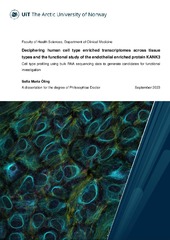| dc.contributor.advisor | Butler, Lynn | |
| dc.contributor.author | Öling, Sofia Maria | |
| dc.date.accessioned | 2023-10-30T10:38:49Z | |
| dc.date.available | 2023-10-30T10:38:49Z | |
| dc.date.issued | 2023-11-13 | |
| dc.description.abstract | The identification of cell type-specific genes and their modification under certain conditions is essential for our understanding of the human body. Such knowledge also allows us to study the function of uncharacterised genes in the correct cell type. Single-cell RNA sequencing (scRNAseq) can be used to profile different cell types, but cell removal and processing can introduce artifacts. In the presented thesis, we used unfractionated bulk RNA sequencing (RNAseq) data to identify cell type-specific transcriptomes, and furthermore, used the generated data to select a candidate gene for functional analysis in endothelial cells (EC).
We used an integrative correlation-based method to analyze RNAseq data from the Genotype Tissue Expression Project (GTEx). The gastrointestinal tract organs stomach (paper I) and colon (paper II) were analyzed. In both cases, we profiled cell-enriched transcriptomes of cell types that are absent from the major scRNAseq databases and identified several non-coding genes with cell type enriched profiles. A sex-based subset analysis revealed that cell profiles were broadly similar in males and females. We extended our analysis to include 15 human organs (paper III). A cross-tissue analysis revealed common cell type enriched gene signatures between related cell types, or the same cell types found in different tissues, such as EC.
We subsequently selected one of the most consistently EC enriched genes, which had no described function in this cell type, for further study, KANK3 (paper IV). We found that KANK3 was regulated by shear stress. EC KANK3 depletion also revealed a role in EC migration, and in regulation of tissue factor (TF) expression, which is involved in coagulation.
These studies provide a roadmap for cell type enrichment profiles and demonstrate how such data can be used to select genes for functional investigation. Additionally, highlighting the value of using alternative methods to extract information from previously published data. | en_US |
| dc.description.doctoraltype | ph.d. | en_US |
| dc.description.popularabstract | The study of cell type-specific genes and how they are modified under various conditions is important for our understanding of the human body. This can be done by analyzing individual cells, but the techniques used can introduce artifacts, so we analyzed tissue samples containing cells in their natural state. We identified cell type-enriched genes in stomach and colon tissue and identified a small set of genes with a higher expression in men. By expanding our analysis to multiple organs, we identified genes expressed in same cell types across different tissues, including endothelial cells (EC), which line all blood vessels. We studied the function of the EC gene KANK3 and found that it has a role in cell movement and blood clotting. We show the value of using alternative methods to analyze existing data, and how such data can be used to select genes for functional studies. | en_US |
| dc.identifier.uri | https://hdl.handle.net/10037/31642 | |
| dc.language.iso | eng | en_US |
| dc.publisher | UiT The Arctic University of Norway | en_US |
| dc.publisher | UiT Norges arktiske universitet | en_US |
| dc.relation.haspart | <p>Paper I: Öling, S., Struck, E., Thorsen, M.N., Zwahlen, M., von Feilitzen, K., Odeberg, J., … Butler, L.M. A human stomach cell type transcriptome atlas. (Submitted manuscript). Pre-print also available on <i>BioRxiv</i> at <a href=https://doi.org/10.1101/2023.01.10.520700>https://doi.org/10.1101/2023.01.10.520700</a>.
<p>Paper II: Öling, S., Struck, E., Thorsen, M.N., Zwahlen, M., Odeberg, J., Pontén, F., … Butler, L.M. A human colon cell type transcriptome atlas. (Manuscript).
<p>Paper III: Dusart, P., Öling, S., Struck, E., Norreen-Thorsen, M., Zwahlen, M., von Feilitzen, K., … Butler, L.M. A tissue centric atlas of cell type transcriptome enrichment signatures. (Manuscript). Pre-print also available on <i>BioRxiv</i> at <a href=https://doi.org/10.1101/2023.01.10.520698>https://doi.org/10.1101/2023.01.10.520698</a>.
<p>Paper IV: Struck, E.C., Öling, S.M., Dusart, P.J., Norreen-Thorsen, M., Eckel, J.C., Kruse, L.D., … Butler, L.M. KANK3 is a shear stress regulated endothelial protein with a role in cell migration and tissue factor regulation. (Manuscript). | en_US |
| dc.relation.isbasedon | <p>The GTEx Consortium (2015). The Genotype-Tissue Expression (GTEx) pilot analysis: multitissue gene regulation in humans. <i>Science, 348</i>(6235), 648–660. Available at <a href=https://doi.org/10.1126/science.1262110>https://doi.org/10.1126/science.1262110</a>.
<p>Ashburner, M., Ball, C.A., Blake, J.A., Botstein, D., Butler, H., Cherry, J.M., … Sherlock, G. (2000). Gene Ontology: Tool for the Unification of Biology. <i>Nature Genetics, 25</i>(1), 25–29. Available at <a href=https://doi.org/10.1038/75556>https://doi.org/10.1038/75556</a>.
<p>Uhlen, M., Fagerberg, L., Hallstrom, B.M., Lindskog, C., Oksvold, P., Mardinoglu, A., … Pontén, F. (2015). Tissue-based map of the human proteome. <i>Science, 347</i>(6220), 1260419. Available at <a href=https://doi.org/10.1126/science.1260419>https://doi.org/10.1126/science.1260419</a>.
<p>The Tabula Sapiens Consortium (2022). The Tabula Sapiens: A multiple-organ, single-cell transcriptomic atlas of humans. <i>Science, 376</i>(6594), eabl4896. Available at <a href=https://doi.org/10.1126/science.abl4896>https://doi.org/10.1126/science.abl4896</a>.
<p>Guo, J., Grow, E.J., Mlcochova, H., Maher, G.J., Lindskog, C., Nie, X., … Cairns, B.R. (2018). The adult human testis transcriptional cell atlas. <i>Cell Research 28</i>, 1141-1157. Available at <a href=https://doi.org/10.1038/s41422-018-0099-2>https://doi.org/10.1038/s41422-018-0099-2</a>.
<p>Rouillard, A.D., Gundersen, G.W., Fernandez, N.F., Wang, Z., Monteiro, C.D., McDermott, M.G. & Ma'ayan, A. (2016). The harmonizome: a collection of processed datasets gathered to serve and mine knowledge about genes and proteins. <i>Database, 2016</i>, baw100. Available at <a href=https://doi.org/10.1093/database/baw100>https://doi.org/10.1093/database/baw100</a>.
<p>Mi, H., Muruganujan, A., Casagrande, J.T. & Thomas, P.D. (2013). Large-scale gene function analysis with the PANTHER classification system. <i>Nature Protocols, 8</i>, 1551–1566. Available at <a href=https://doi.org/10.1038/nprot.2013.092>https://doi.org/10.1038/nprot.2013.092</a>. | en_US |
| dc.rights.accessRights | openAccess | en_US |
| dc.rights.holder | Copyright 2023 The Author(s) | |
| dc.rights.uri | https://creativecommons.org/licenses/by-nc-sa/4.0 | en_US |
| dc.rights | Attribution-NonCommercial-ShareAlike 4.0 International (CC BY-NC-SA 4.0) | en_US |
| dc.title | Deciphering human cell type enriched transcriptomes across tissue types and the functional study of the endothelial enriched protein KANK3 | en_US |
| dc.type | Doctoral thesis | en_US |
| dc.type | Doktorgradsavhandling | en_US |


 English
English norsk
norsk
